| NORMAL
EVENTS OF THE FELINE LUTEAL PERIOD
 414 414

Pseudopregnancy
- Pseudopregnancy results when ovulation and corpora
lutea formation occurs but pregnancy does not result.
- The corpora lutea produce progesterone which rises
rapidly from basal concentrations (0.5 ng/ml) to 8.0 ng/ml 5 days
after ovulation to a peak of 16 to 17 ng/ml 18 to 25 days post
ovulation.
- Following the peak, progesterone concentrations
decline to basal values at approximately 40 days post ovulation. The
normal duration of pseudopregnancy has been observed to be from 35
to 40 days with an average of 36.5 days.
- The corpora lutea appear to have a preprogrammed
finite lifespan in that they are not subject to regression from
uterine sources of prostaglandins as is the case with cattle and
horses.
- The corpora lutea also have been shown to be
resistant to multiple luteolytic doses of prostaglandins through
days 11 to 25 postovulation, indicating that it is clinically
difficult to shorten the time interval from the onset of
pseudopregnancy to the subsequent estrus.
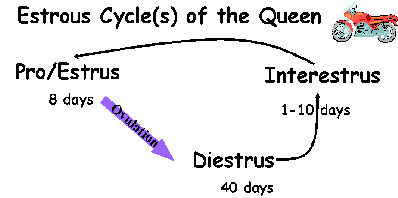
-
-
-
-
-
-
-
-
-
- This interestrus interval normally lasts 30 to 50
days and includes a luteal phase lasting around 35 days followed by
a short 1 to 10 day anestrus phase. This anestrus phase may last
several months if the queen is entering seasonal anestrus at the end
of the pseudopregnant luteal period.
- It is rare for the queen to have overt signs of
lactation (pseudogenetra) at the end of pseudopregnancy as seen in
the bitch.
Pregnancy
- Assuming successful induction of ovulation has
occurred, fertilization can occur if viable sperm meet viable ova.
Sperm cells undergo capacitation in vitro in approximately 1 hour.
- Fertilization probably occurs at the ampulla/isthmic
junction, and the embryos move into the uterine lumen 4-5 days post
coitus.
- Upon entry into the uterus, the embryos migrate for
6-8 days and then spread out so that each embryo has an equal share
of the uterus.
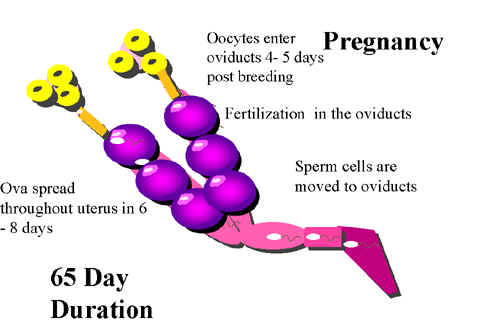
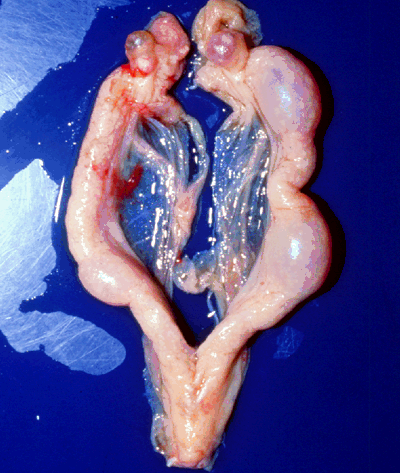
- As the number of ovulations increases to greater
than five, the percentage of embryos that implant at 12-13 days
diminishes from 90% for 5 ovulations to around 53% for 9-11
ovulations. This overcrowding phenomenon results in an observed
average litter size of 4-4.5 kittens, with the largest litters being
6.6 kittens from 8 ovulations.
- The fecundity of queens, therefore, appears limited
by ovulation rates and uterine spacing.
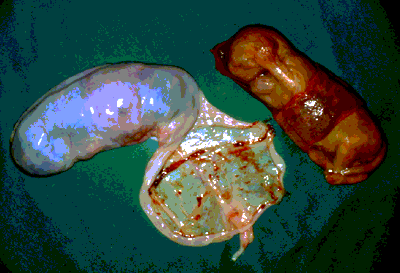

Hormones of pregnancy
- In the pregnant queen, progesterone, secreted by
the corpora lutea, rises rapidly after ovulation and peaks at a
concentration of 30-40 ng/ml on day 21, which is very similar to
that of the pseudopregnant queen. The concentration of progesterone
then gradually falls to basal concentrations through the remainder
of gestation.
- Unlike the pseudopregnant queen, the corpora lutea
may not regress. In the pregnant queen the placenta produces the
enzyme needed for progesterone production starting around days 28-32
of gestation, but the ovaries are still probably needed to maintain
pregnancy to term. Needing the ovaries to term is different than
what has been dogma for many years and still appears in most texts.
- Prolactin from the anterior pituitary increases at
day 35 and peaks about day 50 of gestation. Prolactin appears to be
needed for pregnancy maintenance. When a prolactin inhibitor,
cabergoline, is administered after day 42, abortion results.
- Relaxin, from the fetal-placental unit, is
detectable after 25 days of gestation, remains elevated from day 30
to term and declines abruptly at parturition. Laboratory tests using
relaxin to diagnose pregnancy are being considered for the
commercial market.
- During pregnancy, the queen has been reported to
mate and ovulations at day 10-14 of pregnancy have been reported to
result in a younger, secondary litter. This ovulation and secondary
pregnancy is referred to as superfetation. However, reports on
superfetation are mostly nonscientific and anecdotal so the
phenomenon may not truly exist.
Pregnancy Diagnosis
I
know the cat is not a little dog, but click here to see the canine
pregnancy graphics....the ultrasound and uterus looks the same.
- Pregnancy diagnosis in the queen is easily
determined by abdominal palpation. Discrete swellings in the uterus,
which are the evenly spaced out fetal-placental units, can be
palpated as early as day 16 post coitus in some queens until
approximately day 30.
- After day 30, the fetal-placental units converge so
that the discrete swellings become confluent. Radiography can be
used to diagnose pregnancy after fetal mineralization occurs at
about day 43 post coitus. At this stage, counting the number of
conceptuses radiographically is easily performed.
- Ultrasound can be used to determine pregnancy as
early as day 14-15 post coitus. The gestational sac appears as a
round nonechogenic (black) structure located within a hyperechoic
(white) uterus. Heartbeats are visible in the fetus starting around
day 20. Although it is difficult to count the number of conceptuses
accurately using ultrasound, the presence of fetal heartbeats gives
an absolute indication of fetal life. The determination of fetal
life is important in establishing when and if an early embryonic
death occurs.
Care During Pregnancy
- Care of the pregnant queen should include adequate
nutrition, adequate exercise, isolation from potentially infectious
diseases and restraint from administration of vaccines or
medications if at all possible.
- Queens eat more as gestation progresses. In one
report individual queens ate an average of 178 gm of canned food
during the first week of pregnancy, 267 gm during week 7 and 256 gm
during week 8. Queens with larger litters tended to gain more weight
than those with smaller litters, with an average gain of about 900
gm. The caloric requirement for pregnant queens is 100 kcal/kg of
body weight. The ration must be balanced and specifically designed
for cats.
- Vitamin A is essential in the queen's diet. Taurine
deficiency may result in abortion or small kittens. Lack of adequate
vitamin A can also cause early embryonic death and abortions.
Gestation Length
- Gestation length in the cat is 63 to 66 days when
measured from a fertile mating. Because kittens born before 60 days
of gestation have little chance of survival, it is important that
gestation progress to 63 days for maximum kitten viability.
Induction of Abortion
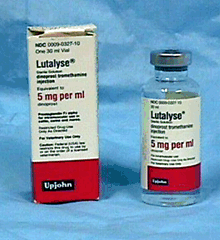
- Prostaglandin F2alpha
given at a dosage of 0.5 mg/kg IM daily for 2 days after day 40 of
gestation can induce abortion within 8 to 48 hours after
administration. Abortion of dead kittens or the birth of live,
viable kittens is dependent upon the duration of gestation.
|

